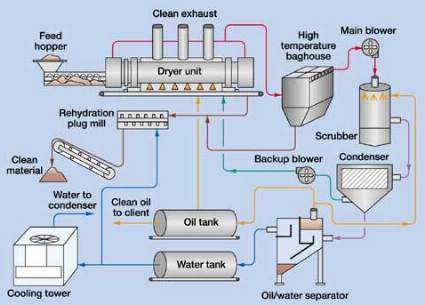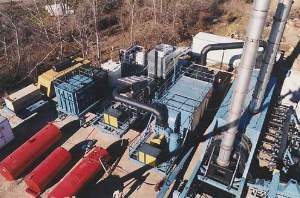01-02_technology-staff_3.htm (Feb-2001)
TECHNOLOGY AT WORKThermal desorption: An alternative OBM cuttings treatmentFaced with tightening regulations governing discharge and disposal of oil-based mud (OBM) drilled cuttings, oil companies are left with limited and expensive alternatives. OBMs are generally preferred on directional or difficult, straight-hole drilling operations because they provide necessary borehole integrity and lubricating properties which can reduce costly drilling problems and time-to-TD. Alternative mud systems include water-based mud, which may not be feasible on these more difficult wells, and synthetic-based muds that can cost up to ten times more than conventional OBM. Traditional treatment / disposal methods for OBM cuttings and typical associated problems include: Injection – slurrification and pumping of the cuttings into a "safe" formation. While injection often appears to be the most-cost-effective solution, it may not be feasible because of well location, formation constraints, or local regulations. Also, there is the risk of future contamination of the surface or water source if the injection process is poorly designed or executed. Bioremediation – mixing cuttings with clean soil; introducing oxygen, nitrogen and phosphorus nutrients into the material; and controlling moisture levels to promote the growth of bacteria that breakdown the hydrocarbons over time. Bioremediation requires large land treatment cells and long periods of time, generally up to a year or longer. Landfarming is similar to bioremediation, but it involves mixing large amounts of clean soil with the contaminated cuttings until the composite mix has a total petroleum hydrocarbon (TPH) level below local regulatory requirements. Encapsulation and fixation – mixing cuttings with a stabilizing agent such as lime, cement, sodium silicate to form a stable matrix, trapping liquids. Success depends on complete blending of the cuttings and stabilizing agent, and it is susceptible to poor mixing, weak matrix formation and eventual leaching of the oil. Alternative problem solution. A relatively new method to treat drilled cuttings is "indirect thermal desorption." This method eliminates the liability of future contamination of the environment while reducing the amount of land required and treatment time involved. This method provides for source reduction of wastes and allows the oil to be recovered and recycled, rather than being lost to the environment. The continual-feed, indirect-thermal-desorption system, Fig. 1, can be set up at a drillsite or central processing facility, Fig. 2. OBM cuttings are first weighed, then placed into a holding hopper equipped with a variable-speed, auger feeder that meters material fed into the rotary dryer at a rate up to 15 mt (metric tons), (wet) per hour. The dryer unit is designed to dry and heat the cuttings indirectly so that burner combustion gases do not come in contact with the cuttings or the hydrocarbons.
The externally heated rotary dryer is sealed on either end to limit oxygen entering the system, and vapor exiting. The dryer shell heats cuttings to between 600 and 900°F by conductive heat transfer. Retention time within the drum varies between 20 and 30 min. to thoroughly heat and vaporize all of the liquids. Cleaned cuttings exit as dry, inert dust, and are rehydrated with water to a manageable consistency prior to non-hazardous disposal or use in construction materials, e.g., bricks, road base or cover for a sanitary landfill. The hot oil and water vapors are filtered through a high-temperature, fabric-filter baghouse for fine particulate removal, and subsequently condensed into liquid by means of a shell and tube condenser system cooled by a closed-loop cooling tower. The fluid then passes through an oil / water separator system, with recovered water used as makeup water for the cooling tower and cuttings rehydration, and recovered oil returned to the client for reuse in the mud system (or other use), with a small portion used to fuel the self-contained, thermal-desorption process. Air emissions from the system are well below EPA’s 1990 Clean Air Act for Particulate Matter, SOx, NOx and VOCs, and EPA has designated this type of system as "BDAT" (Best Demonstrated Available Technology) for cleanup of hydrocarbon-contaminated soils. Application in Colombia. The patented THOR (Thermal Oil Recovery) system developed by Brandt has been operating since February 1999, in Colombia, South America, for BP. The system is set up at a strategically located site within several miles of surrounding drilling rigs, and cuttings are trucked to the system. BP estimates that savings in Colombia of about $2,000,000 per well are realized with this new thermal desorption technology because of: 1) better wellbore stability inherent with OBM, compared to water-based mud; 2) lower drilling time required per well; 3) process cost savings compared to other disposal alternatives; and 4) use of recovered diesel as fuel and base fluid for drilling mud. The THOR unit is currently processing an average 5,000 – 6,000 mt per month of diesel-based mud cuttings contaminated with 25 – 30% oil and 20 – 25% water (by volume), without using dilution prior to treatment, see table. To date, the system has treated over 120,000 mt of cuttings, and recovered more than l.6 million gal oil. The processed cuttings are typically below 10-ppm TPH; and the recovered oil is very clean, with solids content between non-detectable and 0.02% by volume, as shown in the accompanying table.
For each ton of cuttings processed in Colombia, the system recovers about 0.6 bbl of diesel valued locally at $52/bbl. At an average 260-mt-per-day process rate, this equals $8,112 per day savings to the operator. Using a value of $300/bbl for a synthetic-base fluid or mineral oil, the savings would extrapolate to about $46,800 per day. In this particular case, BP has determined that thermal desorption is the least-expensive treatment option available. Besides the obvious economical savings, BP Colombia has realized many social / environmental benefits from this operation, including:
Brandt makes several sizes of units for mobile or
central-facility operations and is currently looking into the possibility of a scaled-down system for offshore
use and heli-transportable operations. Bibliography
|
|||||||||||||||||||||||||||||||||||||||||||||||||||||||||
- Applying ultra-deep LWD resistivity technology successfully in a SAGD operation (May 2019)
- Adoption of wireless intelligent completions advances (May 2019)
- Majors double down as takeaway crunch eases (April 2019)
- What’s new in well logging and formation evaluation (April 2019)
- Qualification of a 20,000-psi subsea BOP: A collaborative approach (February 2019)
- ConocoPhillips’ Greg Leveille sees rapid trajectory of technical advancement continuing (February 2019)




